US & European Fiber Optic Cable Market Size
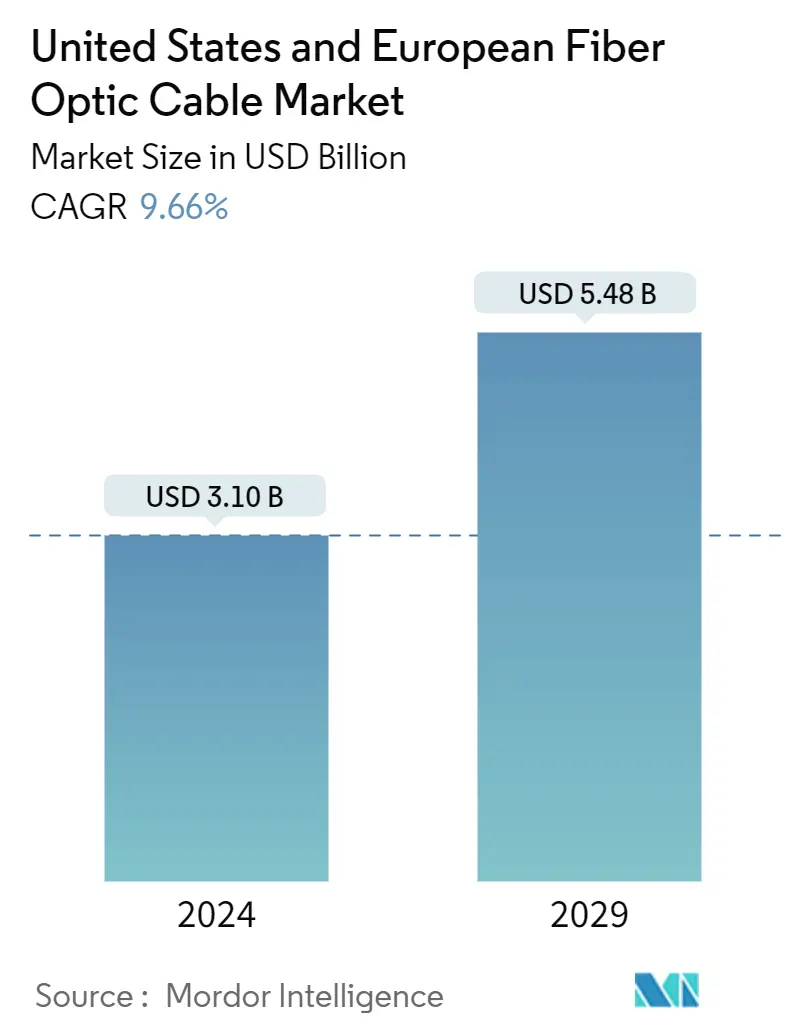
| Study Period | 2019 - 2029 |
| Base Year For Estimation | 2023 |
| Market Size (2024) | USD 3.10 Billion |
| Market Size (2028) | USD 5.48 Billion |
| CAGR (2024 - 2029) | 9.66 % |
| Market Concentration | Low |
Major Players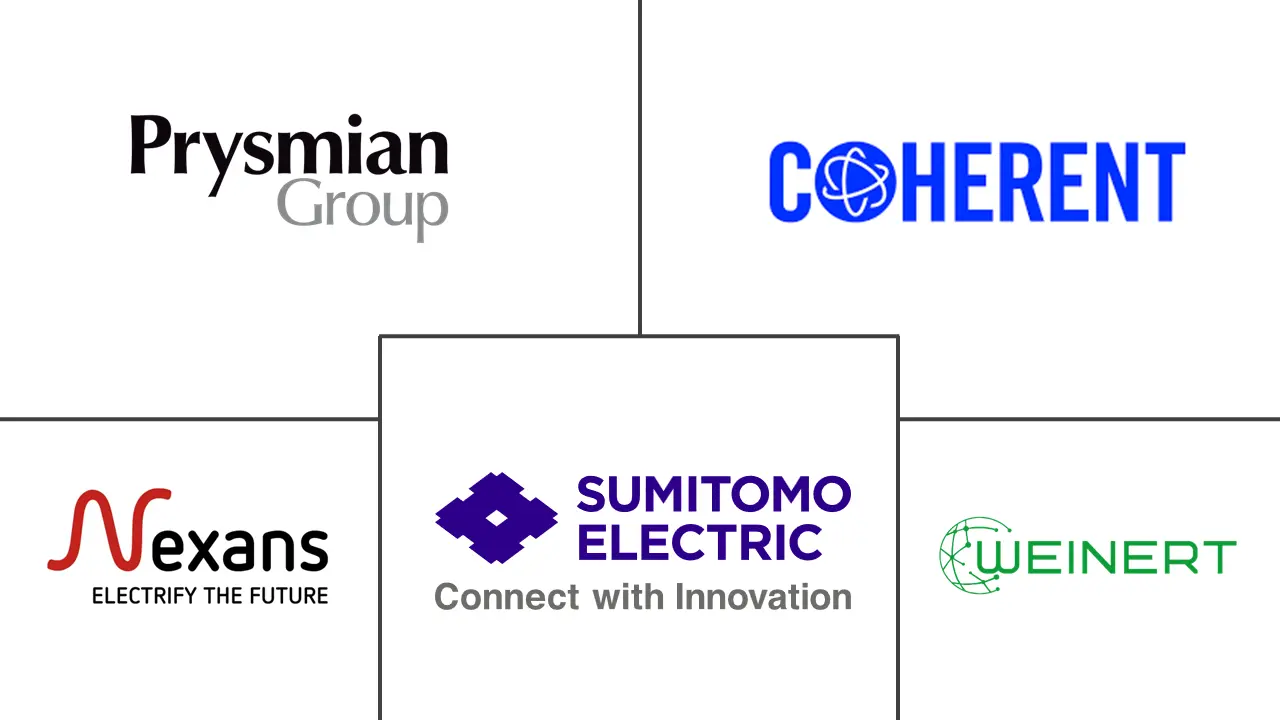
*Disclaimer: Major Players sorted in no particular order |
US & European Fiber Optic Cable Market Analysis
The United States And European Fiber Optic Cable Market size is estimated at USD 3.10 billion in 2024, and is expected to reach USD 5.48 billion by 2028, growing at a CAGR of 9.66% during the forecast period (2024-2028).
- The evolution of fifth-generation networks & fiber optic infrastructure has driven digital transformation across industries. Optic fiber cable presents better security, reliability, bandwidth, and security than copper cables. The distinction between a fiber optic cable and a copper wire is that the fiber optic cable utilizes light pulses to transfer information down the fiber lines rather than electronic pulses to transmit information through the copper lines.
- With increasing online transactions & virtual meetings, companies need 5G and optic fiber cable to remain competitive. For instance, according to the European Central Bank, online payments share in consumers' non-recurring payments increased to 17% in 2022 from just 6% in 2019. Hence, to support such trends robust infrastructure such as high-speed internet is required which is anticipated to create opportunities in the studied market.
- Furthermore, fiber optic cables are cost-effective, convenient, & easy solutions for numerous industrial applications, like lighting and decorations, data transmission, surgeries, and mechanical inspections. The growing work-from-home & hybrid work model also drives the need for FTTH throughout the United States and Europe.
- Data traffic growth, specifically Internet Protocol (IP), drives the surge in need for high network bandwidth. Prominent service providers registered bandwidth doubling on their backbones every six to nine months. Due to growing internet traffic, bandwidth doubles every 6 to 9 months.
- The expansion of fiber-integrated infrastructure in the US and the European market has also immensely raised the need for fiber-optic cables, particularly in the telecom industry. Fiber-optic networks and fiberoptic wires have also greatly improved owing to broadband installations. These architectures include FTTH, FTTP, FTTC, & FTTB.
- The increase in the need for connectivity in developing nations for fiber-optic producers offers significant business prospects. Yet factors like the advancement in wireless solution demand & the difficulty of deploying fibreoptic cables provide several operational difficulties for the market's growth.
- Macroeconomic factors also influence the studied market's growth significantly as both the United States and the European regions have been witnessing economic downturns post-covid. Furthermore, geopolitical issues such as the Russia-Ukraine war, and the US-China disputes also creates a challenging environment for an uninterrupted growth of the market.
US & European Fiber Optic Cable Market Trends
Rising Investment in Fiber Optic and 5G Deployment Drives the Market
- The US and European markets have been among the early adopters of advanced telecom technologies and continue to remain so. Factors such as the presence of developed ecosystems and higher consumer penetration of digital technologies support encourage the industry stakeholders to increase investments in fiber optic and telecom infrastructure. For instance, Corning, the telecom service provider, recently disclosed plans to design Arizona's first fiber network in 2023, anticipated to serve over 100,000 residences.
- Additionally, the studied regions also have the presence of some of the biggest fiber optic cable companies who continue to expand their regional presence; for instance, CommScope is among the leaders in fibreoptic innovation and drives the boundaries of high-performance fiber connectivity for the most challenging networks. Since the company also sets industry standards, its fiber-optic cabling systems always transcend requirements.
- The growing deployment of 5G in the US and European markets also favors the studied market's growth. For instance, Ericsson, recently stated that the 3.5 GHz (5G) roll-out will be conducted in Germany by 2025. The 3.5 GHz 5G network would constitute 43% of the total German population by 2025, up from 42%, which is anticipated in 2023. However, only 7% of the geographical region in Germany is expected to be covered in 2025.
- Similarly, the US National Science Foundation (NSF) concentrates on accelerating 5G solutions to support US critical infrastructure and government operators to communicate securely anytime and anywhere. For instance, in September 2022, NSF announced a partnership with the Department of Defense Office. With an investment of USD 12 million, NSF selected 16 teams for the Convergence Accelerator program in 2022. These teams were chosen for "Track G: Securely Operating Through 5G Infrastructure". Track G promotes technology advancement to develop 5G communications for the US federal government & military.
- Adtran, the US-based networking & communications solutions provider, enables the building of full-fiber networks employing passive optical network technologies that provide gigabit access to businesses and homes and for infrastructure backhaul. In January 2023, the company established its SDX 6330 10 Gbit/s combo passive optical network fiber access platform, which allows service providers to cost-effectively and quickly connect businesses & homes with fiber-based broadband. The new solution provides the highest port density in the industry and is the foremost optical line terminal incorporated with 400 Gbit/s uplinks.
- Furthermore, the growing data consumption is also creating opportunities in the studied market by driving investment in new optical fiber cable networks which supports the data connectivity. For instance, in November 2022, Arelion, a Swedish connectivity provider, unveiled a plan to create two high-capacity fiber optic routes through Texas between Mexico & the United States. The new dense wavelength division multiplexing routes will meet the increasing demand for high-capacity, scalable bandwidth transport & simplify access to Mexico's local markets for over-the-top suppliers in the United States, Asia, and Europe.
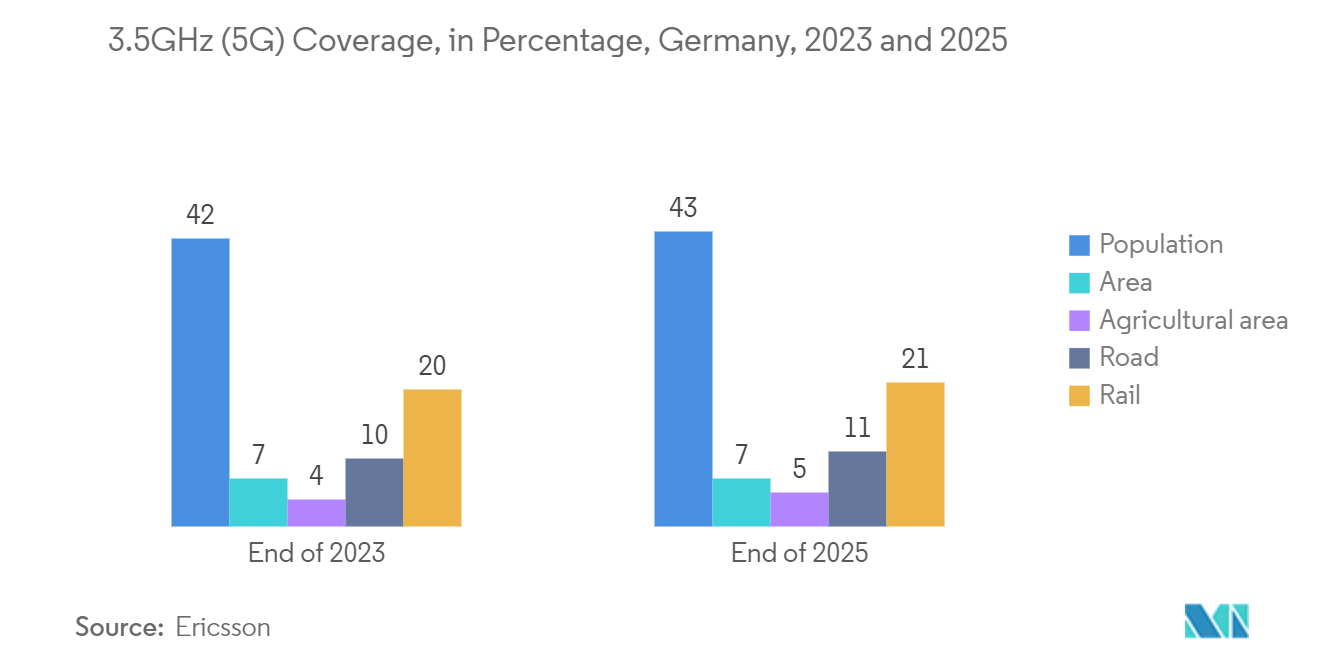
Telecommunication End-user Industry Holds Significant Market Share
- Optical fiber cable (OFC) is a vital building block in the telecommunication infrastructure. Over the last decade, fiber optics have been catering to forceful bandwidth needs, especially from telecommunication companies, and have become the choice of transmission medium. The Studied regions have the presence of some of the biggest telecommunication companies, such as AT&T, Verizon, Sprint, Vodafone Group, etc., who are continuously expanding their optical fiber network to increase their global and regional presence, which creates opportunities in the studied market.
- The eruption of data traffic from different sources, like the internet, e-commerce, computer networks, and multimedia (voice, data, and video), has shown the requirement for a transmission medium capable of managing higher bandwidth to handle such vast amounts of information. According to Eurostat, the share of daily internet users in the European Union had increased to 84% in 2022, compared to 74.07% in 2028. As fiber-optic cables, with comparatively infinite bandwidth, are among the key solutions to this problem, the demand is anticipated to remain high.
- In telecommunication networks, fiber optic cables join different network nodes, like cell towers, data centers, and internet service providers, allowing the exchange of extensive amounts of data between different locations. Fiber-optic cables also have suitable for developing high-speed internet connections & other advanced communication technologies such as video conferencing, online gaming, and cloud computing. Hence, the expanding 5G network footprint in the United States and the European region is anticipated to drive opportunities in the studied market.
- Moreover, owing to their security, scalability, and the unlimited bandwidth potential to handle the vast amount of backhaul traffic being generated, fiber-optic cables are also being selected to support the bandwidth levels catering to evolved technologies like 5G, Big Data and IoT that rely heavily on real-time data gathering and transfer. The launch of 5G is predicted to improve the capacity and lower latency straight to networks.
- The internet has been one of the significantly transformative and fast-growing technologies in the studied regions which is driving opportunities in the studied market as optical fiber cables are widely used in the data and the telecommunication industry. For instance, according to Ericsson, datatraffic per smartphone continues to grow in the studied regions, for instance, in North America, data traffic per smartphone is anticipated to growth from 13 GB/month in 2021 to 58 GB/month in 2028. Similarly, in Western Europe, it is anticipated to grow from 16GB/month in 2021 to 56GB/month by 2028.
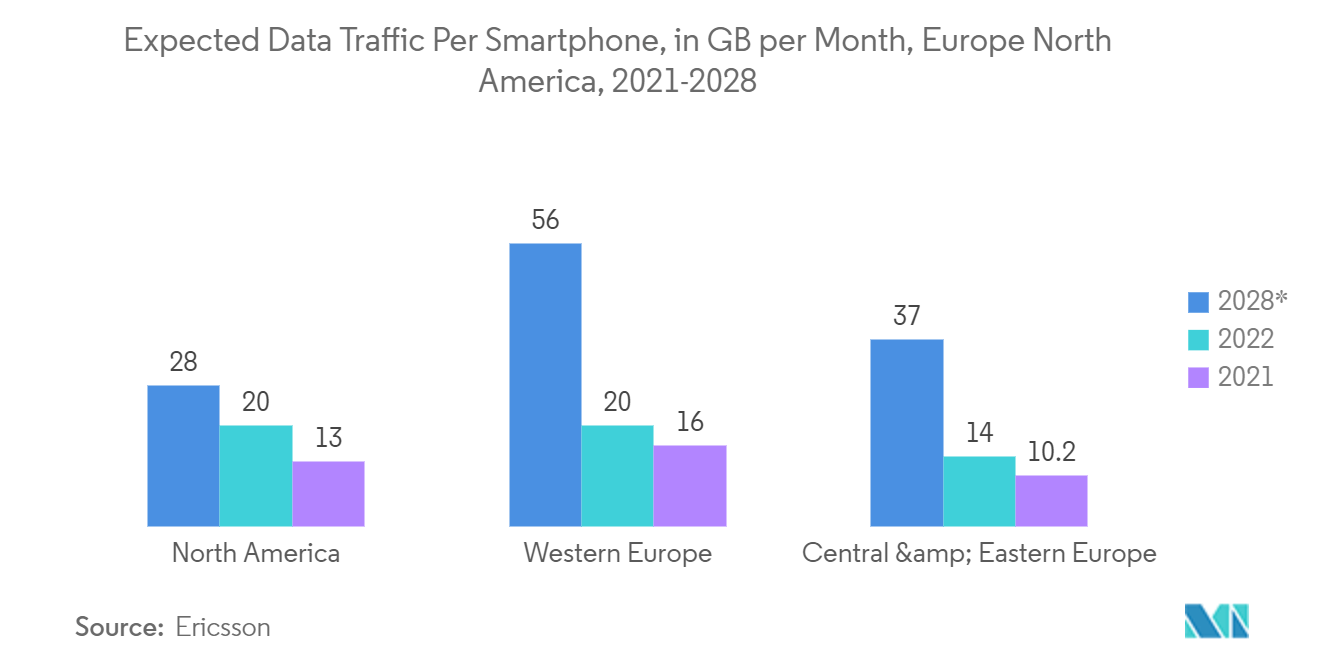
US & European Fiber Optic Cable Industry Overview
The United States and European fiber optic cable market is fragmented, with major players like Nexans SA, Prysmian Group, Weinert Industries AG, Coherent Corporation, and Sumitomo Corporation. Players in the market are embracing strategies like partnerships, acquisitions, and mergers to enhance their product offerings and gain sustainable competitive advantage.
- March 2023 - CommScope, a global network connectivity solution, announced expansions to its fiber-optic cable production to accelerate broadband rollout across the U.S., connecting more communities and underserved areas. According to the company, this initiative will increase fiber-optic cable output in the U.S., hastening broadband deployment to underserved communities. Additionally, the company's HeliARC lines are expected to support 500,000 homes per year in FTTH deployments.
- March 2023 - European Eunion announced obligations to equip buildings with fiber-optic cables in line with its 2030 policy program for the digital decade. As per the new regulation, it will be mandatory to keep passive infrastructure (mini ducts) and in-building fiber wiring (fiber optic cables) in newly contracted buildings or buildings undergoing major renovations, up to the network termination point in the apartment/unit. EU is also planning to provide certification to the buildings that are 'fiber ready. Such trends are anticipated to drive the demand for fiber optic cables.
US & European Fiber Optic Cable Market Leaders
-
Nexans SA
-
Prysmian Group
-
Weinert Industries AG
-
Coherent Corporation
-
Sumitomo Corporation
*Disclaimer: Major Players sorted in no particular order
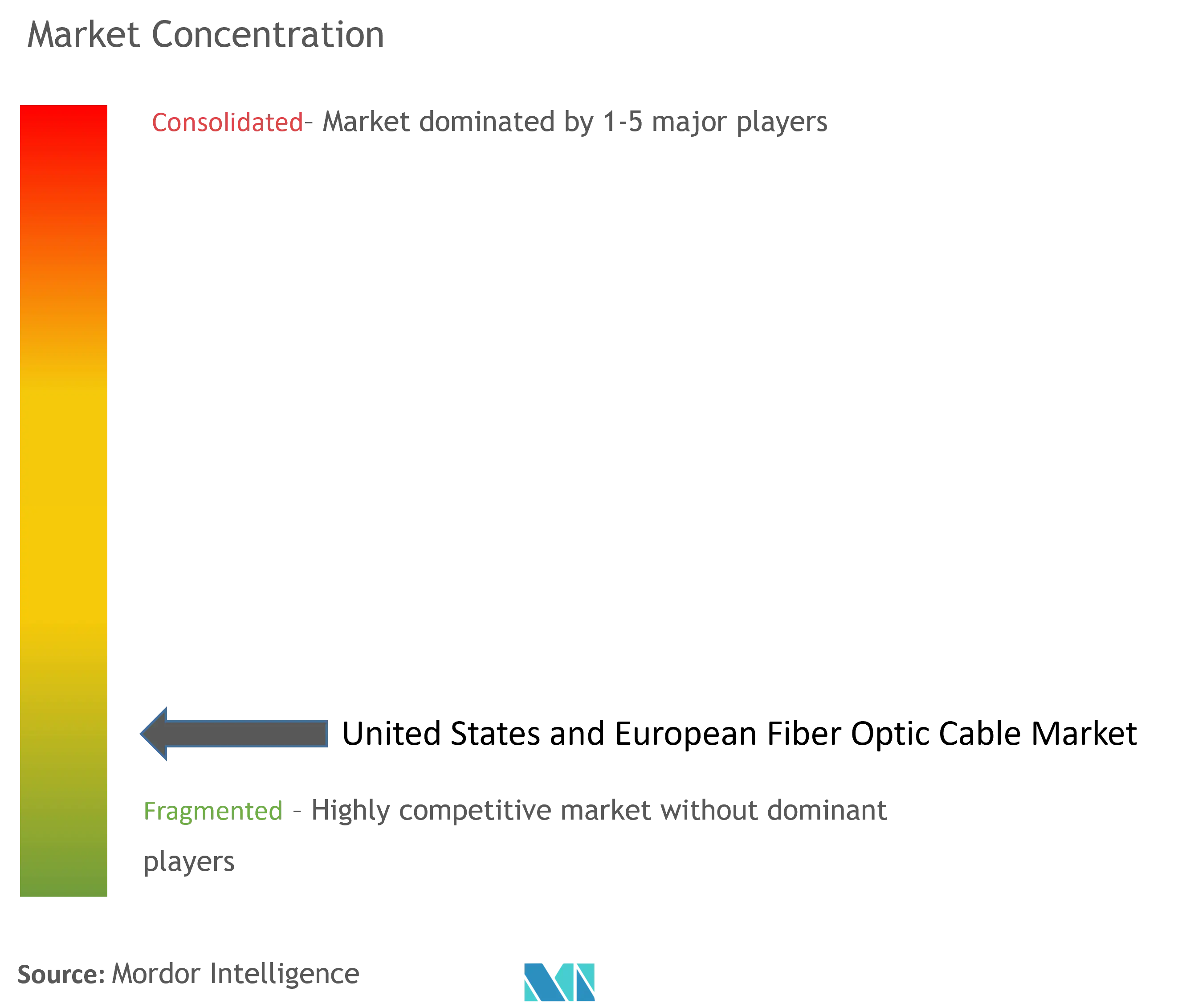
US & European Fiber Optic Cable Market News
- January 2023 - Italy-based Prysmian Group introduced an 864-fiber version of its Sirocco HD micro duct cables. The new cable squeezes 864 fibers into a diameter of 11.0 mm, which produces a fiber density of 9.1 fibers per square millimeter. The fiber cable can be installed in a 13-mm duct.
- October 2022 - STL announced its plans to establish its first U.S. cable manufacturing plant in South Carolina, United States. According to the company, the manufacturing facility will primarily manufacture optical cables.
- August 2022 - Corning Incorporated announced that it is expanding optical cable manufacturing capacity in response to a long-term engagement with the nation's largest fiber internet provider as the carrier extends fiber service. Corning intends to develop its strategic investments in optical fiber, cable, and connectivity solutions to satisfy the unprecedented need by building a new cable production facility in Gilbert, Arizona, a part of the Greater Phoenix area.
US & European Fiber Optic Cable Market Report - Table of Contents
1. INTRODUCTION
- 1.1 Study Assumptions and Market Definition
- 1.2 Scope of the Study
2. RESEARCH METHODOLOGY
3. EXECUTIVE SUMMARY
4. MARKET INSIGHTS
- 4.1 Market Overview
- 4.2 Impact of Key Macro-economic themes
5. MARKET DYNAMICS
-
5.1 Market Drivers
- 5.1.1 The Increased Data Traffic Creates the Demand for Fiber Optic Cable Network
- 5.1.2 Rising Investment in Fiber Optic and 5G Deployment
-
5.2 Market Challenges
- 5.2.1 Rising Demand For Wireless Solutions and Complex Installation Process
6. MARKET SEGMENTATION
-
6.1 By End-user Industry
- 6.1.1 Telecommunication
- 6.1.2 Power Utilities
- 6.1.3 Defence/military
- 6.1.4 Industrial
- 6.1.5 Medical
- 6.1.6 Other End-user Industries
-
6.2 By Country
- 6.2.1 United States
- 6.2.2 Germany
- 6.2.3 Austria and Switzerland
7. COMPETITIVE LANDSCAPE
-
7.1 Company Profiles*
- 7.1.1 Nexans SA
- 7.1.2 Prysmian Group
- 7.1.3 Weinert Industries AG
- 7.1.4 Coherent Corporation
- 7.1.5 Sumitomo Corporation
- 7.1.6 Corning Inc.
- 7.1.7 Finisar Corporation
- 7.1.8 Leoni AG
- 7.1.9 Folan
- 7.1.10 Molex LLC
- 7.1.11 Fujikura Ltd
- 7.1.12 Sterlite Technologies
- 7.1.13 Furukawa Electric Co. Ltd
- 7.1.14 Smiths Interconnect (Smiths Group PLC)
8. STATE OF FIBRE OPTICS IN INDUSTRIES
9. FUTURE OUTLOOK OF THE MARKET
** Subject To AvailablityUS & European Fiber Optic Cable Industry Segmentation
Fiber optic technology transmits data by highly flexible, transparent extruded glass or plastic fiber. Fibre optic cables incorporate glass threads as thin as human hair, sending messages modulated into light waves. Although these cables are made of glass, they are highly durable and malleable.
The United States and European Fiber Optic Cable Market is segmented by end-user industry (telecommunication, power utilities, defence/military, industrial, and medical) and by country (United States, Germany, Austria, Switzerland, and the Rest of Europe). The market sizes and forecasts are provided in terms of value (USD) for all the above segments.
| By End-user Industry | Telecommunication |
| Power Utilities | |
| Defence/military | |
| Industrial | |
| Medical | |
| Other End-user Industries | |
| By Country | United States |
| Germany | |
| Austria and Switzerland |
US & European Fiber Optic Cable Market Research FAQs
How big is the United States and European Fiber Optic Cable Market?
The United States and European Fiber Optic Cable Market size is expected to reach USD 3.10 billion in 2024 and grow at a CAGR of 9.66% to reach USD 5.48 billion by 2028.
What is the current United States and European Fiber Optic Cable Market size?
In 2024, the United States and European Fiber Optic Cable Market size is expected to reach USD 3.10 billion.
Who are the key players in United States and European Fiber Optic Cable Market?
Nexans SA, Prysmian Group, Weinert Industries AG, Coherent Corporation and Sumitomo Corporation are the major companies operating in the United States and European Fiber Optic Cable Market.
What years does this United States and European Fiber Optic Cable Market cover, and what was the market size in 2023?
In 2023, the United States and European Fiber Optic Cable Market size was estimated at USD 2.80 billion. The report covers the United States and European Fiber Optic Cable Market historical market size for years: 2019, 2020, 2021, 2022 and 2023. The report also forecasts the United States and European Fiber Optic Cable Market size for years: 2024, 2025, 2026, 2027, 2028 and 2029.
United States and European Fiber Optic Cable Industry Report
Statistics for the 2024 United States And European Fiber Optic Cable market share, size and revenue growth rate, created by Mordor Intelligence™ Industry Reports. United States And European Fiber Optic Cable analysis includes a market forecast outlook for 2024 to 2029 and historical overview. Get a sample of this industry analysis as a free report PDF download.



